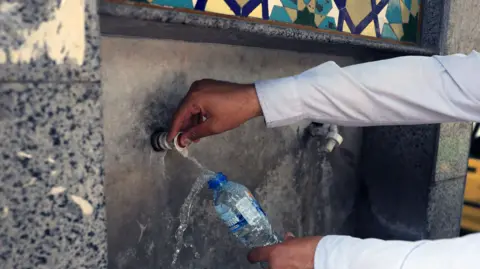 EPA
EPAIran – especially its capital, Tehran – is facing an unprecedented drought this autumn, with rain in recerfoirs empty. Officials are pleading with citizens to conserve water as the crisis deepens.
President Masoud Pezeshkian warned that without enough rain, Tehran’s water supply could be depleted. But he said even the ration may not be enough to prevent a disaster.
“If the rationing doesn’t work,” Pezeshkian said, “We may have to evacuate Tehran.”
His comments prompted criticism in Iranian newspapers and on social media. Former Mayor Gohamhossein KarBaschi called the idea “a joke” and said “the evacuation of Tehran makes no sense.”
Iranian meteorological officials said no rain is expected in the next ten days.
Meanwhile, the water crisis is affecting daily life in the capital.
“I plan to buy water tanks to use for toilets and other necessities,” a woman in Tehran told BBC Persian.
In the summer, Iranian Rapper Vafa Ahmadpoor posted a video on social media that showed a kitchen faucet without running water.
“It’s four or five hours,” he said. “I bought a bottle of water to go to the toilet.”
Dams that are almost empty
The manager of the Burial Dam, one of the main sources of water in Tehran, says that it now has more than ten percent of its capacity. The nearby Karaj Dam – which supplies water to the provinces of Tehran and Alborz – is in a similar state of good condition.
“I have never seen this dam empty since I was born,” an elderly local resident told Iranian State TV.
According to Mohammad-Ali Moallem, the manager of the Karaj Dam, rain falls.
“We have a 92 percent decrease in rainfall compared to last year,” he said. “We have eight percent water in our reservoir – and most of it is unusable and considered ‘dead water.'”
Fear of water cuts
The government is now pinning hopes on late autumn rains, but forecasts are volatile. Iran’s Energy Minister, Abbas Ali Abadi, warned that the situation could force the authorities to cut off water supplies.
“Some nights we can reduce the water flow to zero,” he said.
Officials also announced plans to penalize households and businesses that waste too much water.
 Abedin Taishenreh / EPA / SHUTTERSTOCK
Abedin Taishenreh / EPA / SHUTTERSTOCKPapers, Rivers of War – and a Bath Crisis
Iran’s energy minister Abadi said that the water crisis in Teahran is not only due to the lack of rain. He blamed the water leakage caused by the capital’s century-old infrastructure and also pointed to the previous two-day war with Israel.
During that conflict, Israel targeted the Northern Tehran neighborhood of Tajrish on 15 June. Later videos showed heavy flooding in the area.
The day following the strike, the Israel Defense Forces said it had targeted military “Command Command” centers.
But the crisis is more than the entire capital.
The head of Iran’s National Center for Climate and Drought Crisis Management, Ahmad Vazifeh has warned that, apart from Tehran, dams in many other provinces — including West Azerbaijan, East Azerbaijan and Markazi — are also in a “worrying state”, with water levels in the single-digit percentages.
In Mashhad, Iran’s second largest city, officials are also sounding the alarm.
The governor of Khorasan Razavi Province in northeastern Iran, said that the water reserves of the Mashhad dams have fallen into a “Mega-challenge of drought.”
The CEO of the Water and Wastewater company set even the number lower.
“The storage level of the city’s main dam is below three percent,” said Hossein Esmaeiliian.
“Only three percent of the combined capacity of Mashhad’s four water supplies – Torogh, Kardeh, Dousto, and Ardak – are still non-operational.”
A crisis that was long overdue
Iran’s water crisis is decades in the making.
Even the Supreme Court of Iran, Ayatollah Ali Khamenei, has always recognized the threat of energy – talking about water shortages in 2011 and other occasions in the following years.
Little has changed though.
Now, Tehran, Karaj and Mashad – home to more than 16 million people alike – face the very real possibility of their taps running dry.


